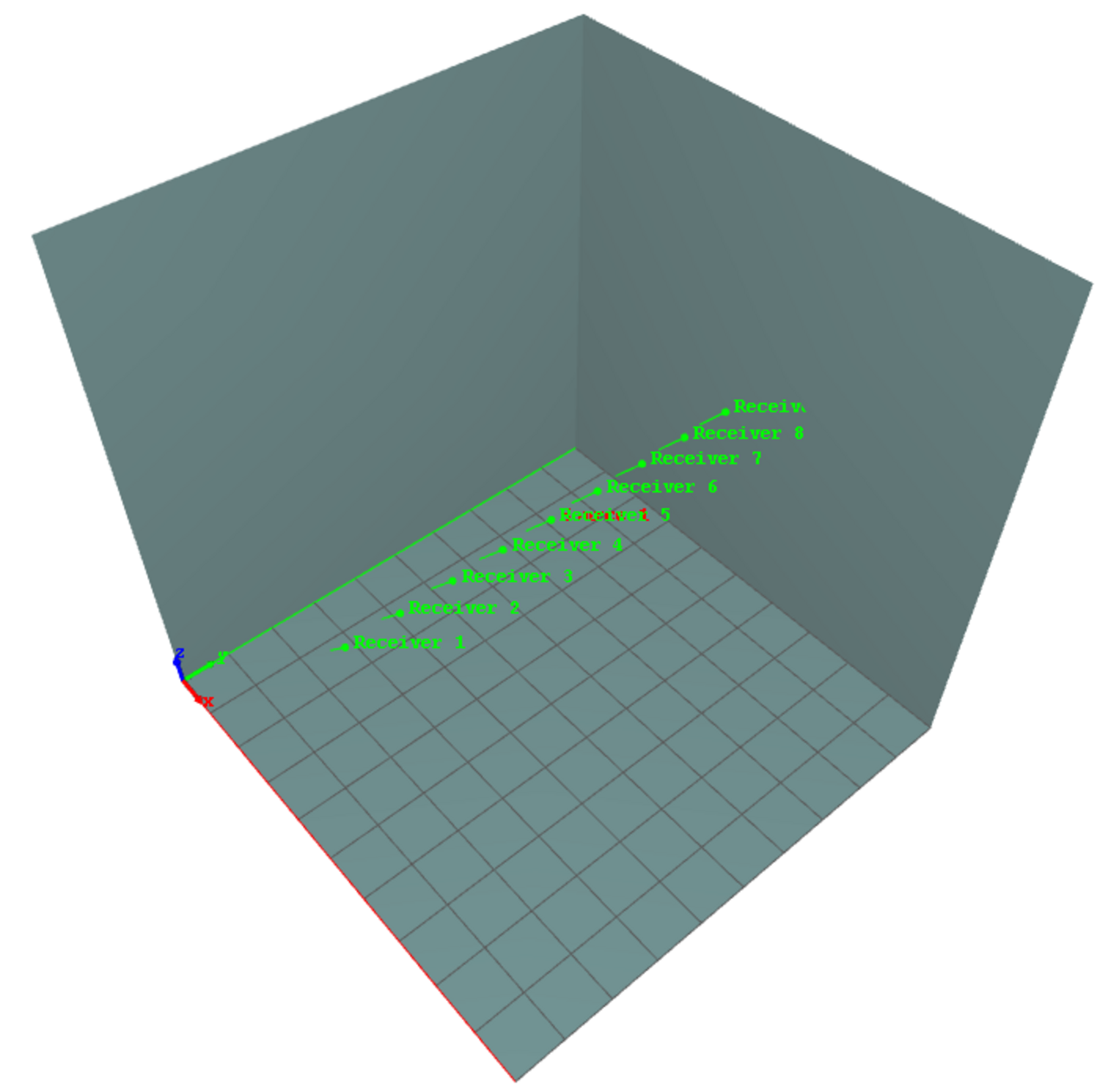All elements of this simulation are licensed under Licence Creative Commons Attribution 4.0 International License.
Cubic room with diffuse reflection and uniform absorption (0.1 and 0.5)
Description
Academic case: Cubic room (10m x 10m x 10m) with 100% diffuse reflection and 10% or 50% uniform surface absorption, with a single source at center and a line of 9 punctual receivers at locations (5,1:1:9,5).
What is tested?
Comparison between I-Simpa simulations (TCR, SPPS, MD) using the geometry described in [Valeau, 2006]. This allows to compare numerical results in an ideal geometry for creating a diffuse sound field.
[Valeau, 2006] Valeau, V., Picaut, J., Hodgson, M. , "On the use of a diffusion equation for room-acoustic prediction", J. Acoust. Soc. Am. 119, 1504 (2006). doi.org/10.1121/1.2161433
CAUTION - The following results present comparisons between numerical simulations carried out with I-Simpa and 'reference' data available in the scientific literature.
- It is difficult to prejudge the concept of 'reference'. The deviation between the simulations and the reference data that can be observed do not necessarily call into question the corresponding simulations but can also be associated with other sources of deviation (modeling assumptions, numerical instabilities, experimental uncertainties, etc.).
- Note also that these comparaisons can also show the limitations of some numerical codes.
Results
Total sound level
In this ideal geometry, the reverberated sound field is in the assumptions of a diffuse field. Thus, as expected, the TCR and the MD code are quite appropriate to model the sound field. In addition the SPPS code gives also relevant results. Both TCR/MD/SPPS code gives similar results in term of sound level. The only problem is observe when the receiver is at the exact location of the source, where an artefact (i.e. a singularity) is observed for the TCR/MD codes, since the direct field cannot be calculated (distance source-receiver is equal to 0 in this situation). The two versions of the diffusion model (MD_Comsol (2010), i.e. the old one and the MD_Octave (2018), i.e. the recent one) gives similar results.
Reverberation time (RT30)
Here again, for an uniform absorption of 0.1, since the reverberated sound field is in the full assumptions of a diffuse field, the TCR results should be the expected values. Both SPPS and MD codes gives similar values in comparison with TCR results. However, one can observe a small overestimation of the RT30 using the old version of the MD code (MD_Comsol). Here again, we have also an artefact for the MD code (Octave) at the source location. For an absorption of 0.5, we are no more in the full assumptions of a diffuse field (absorption becomes too large). It explains why the MD/SPPS codes gives slightly different results than the TCR code, that is an expected result. Here again, the MD_Octave code give better result than the MD_Comsol ones. In summary, in this kind of geometry, the MD and SPPS codes are very relevant, going beyond the limits of the TCR model when absorption becomes larger.
Reference (copie 1)
| Parameters | Value |
|---|---|
| Active calculation of Atmospheric absorption | NO |
| Active calculation of diffusion by fitting objects | NO |
| Active calculation of direct field only | NO |
| Active calculation of transmission | NO |
| Calculation method | Energetic |
| Limit value of the particle extinction | 5.0 |
| Number of sound particles per source | 500 000 |
| Number of sound particles per source (display) | |
| Random initialization number | |
| Receiver radius | 0.31 |
| Simulation length (s) | 2.000 |
| Time step (s) | 0.01 |
Reference (copie 2)
| Parameters | Value |
|---|---|
| Active calculation of Atmospheric absorption | NO |
Reference (copie 3)
| Parameters (MD_Octave) | Value |
|---|---|
| Active calculation of Atmospheric absorption | NO |
| Merge with direct field | YES |
| Diffusion equation resolution - Maximum number of iterations | 200 |
| Diffusion equation resolution - Tolerance | 0.000001 |
| Simulation length (s) | 2.000 |
| Time step (s) | 0.001 |
| Parameters (MD_Comsol) | Value |
|---|---|
| Active calculation of Atmospheric absorption | NO |
| Merge with direct field | YES |
| Simulation length (s) | 2.000 |
| Time step (s) | 0.001 |
What is tested?
Comparison between I-Simpa simulations (TCR, SPPS, MD) using the geometry described in [Valeau, 2006]. This allows to compare numerical cases in an ideal geometry for creating a diffuse sound field.
[Veleau, 2006] Valeau, V., Picaut, J., Hodgson, M. , "On the use of a diffusion equation for room-acoustic prediction", J. Acoust. Soc. Am. 119, 1504 (2006). doi.org/10.1121/1.2161433
Description
Academic case: Cubic room (10m x 10m x 10m) with 100% diffuse reflection and 10% or 50% uniform surface absorption, with a single source at center and a line of 9 punctual receivers at locations (5,1:1:9,5).
All elements of this simulation are licensed under Licence Creative Commons Attribution 4.0 International License.


